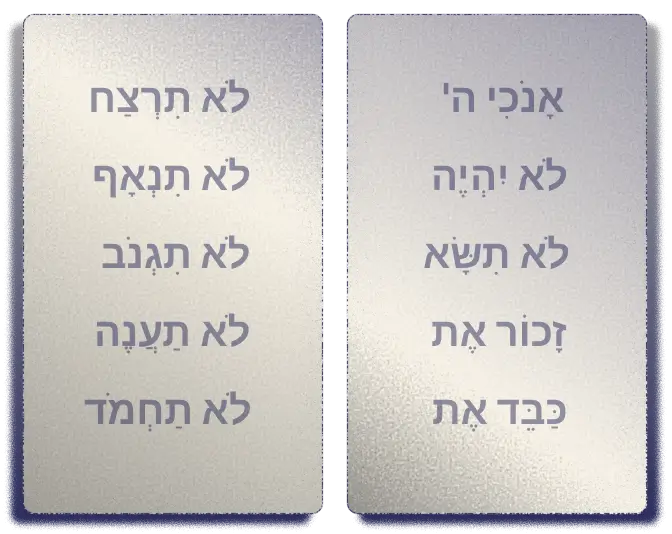

If Zehirut is the pause before the act, Zerizut is the sacred leap forward.
“Zerizut is the eagerness to perform mitzvot.”
— Mesilat Yesharim 6:1-2
Ramchal opens by defining Zerizut as acting before obstacles arise: “Zerizim makdimin la-mitzvot” (Pesachim 4a).
If Zehirut was Avraham’s contemplation beneath the stars, then Zerizut is the moment he rises early — “Vayashkem Avraham baboker” (Genesis 22:3; Bereshit Rabbah 56:1).
He does not wait for confirmation, nor delay for comfort. Awareness ripens into movement; reflection into obedience. The dawn he wakes before becomes the model of spiritual readiness.
When Israel stood paralyzed at the sea, Nachshon ben Amminadav of Judah leapt first (Sotah 37a). The waters split for the one who moved.
Avraham’s first Lech Lecha was the prototype of this courage. Just as Nachshon’s plunge opened the Red Sea, Avraham’s obedience opened history: leaving land, kindred, and logic.
The covenant begins when a human will accelerates toward the Divine command faster than fear can reply.
Ramchal divides Zerizut into two fields (Mesilat Yesharim 7): The first concerns the initiation of an act — that one should not delay when a mitzvah presents itself, but “seize it immediately, without hesitation or deliberation.” The second pertains to its completion — that once begun, the act should not be interrupted or performed sluggishly, “for a mitzvah is not called by his name who begins it, but by his name who finishes it.”
As Ramchal explains:
There are two divisions of alacrity: one prior to the performance of a deed and one during its performance. The first consists in a person's not delaying the mitzvah when the opportunity for it presents itself, but rather seizing it and doing it without delay. The second consists in a person's being diligent in the performance of the mitzvah itself, not lightening his hand from it, but directing his exertion to its speedy completion.
Before the act: seize the mitzvah the instant it appears — “Don’t let it become chametz” (Mechilta to Exodus 12:17).
Avraham embodies this swiftness: when the three guests appear, “he ran from the tent door to meet them” and “hastened to prepare bread and meat” (Genesis 18:6–7).
After the act begins: finish without delay — for “a mitzvah is called by the name of the one who finishes it.”
Avraham completes the Akeidah’s command to its final word; he does not flinch midway. His momentum carries through to completion, the measure of true zeal.
Ramchal names the adversary keveidut (כְּבֵידוּת) — the heaviness that dresses as prudence.In Mesilat Yesharim (Chs. 6–7), keveidut is described as the lethargy of the soul that restrains movement toward the good. It persuades the intellect that delay is wisdom, that moderation is safety, and that passion is folly. Yet beneath this veneer of reason lies spiritual inertia — the weight that keeps a person from acting even when clarity has been attained. Ramchal warns that one who succumbs to keveidut will “wish to serve, but the heaviness of his limbs will prevent him.” True zerizut, he teaches, requires both an inner awakening and a practiced resistance to this false prudence.
Avraham conquers it each time he acts without consulting inertia: leaving Ur, traveling through famine, circumcising himself at ninety-nine. His body’s slowness bows to his soul’s speed.
Shlomo warns that delay corrodes: “A little sleep… and your poverty comes” (Proverbs 6:10–11); “Through sloth the roof sinks” (Ecclesiastes 10:18).
Avraham’s tent, always open on four sides, stands un-decayed — a metaphor for motion defeating stagnation.
The angels who visit Avraham are described as runners of fire; yet, strikingly, he outpaces them.
He imitates their nature: “Vay’maher Avraham…” — he hastens to serve (Genesis 18:6).
Zerizut thus mirrors heaven’s tempo: “Mighty ones who do His word” (Psalms 103:20); “Creatures darting like lightning” (Ezekiel 1:14).
Avraham’s movements are angelic deeds performed willfully and like lightning.
Ramchal teaches that outer motion awakens inner fire, and inner fire demands outer motion.
Avraham lives this loop: his outward journey to Canaan ignites inward love; his inner faith erupts as outward service.
R. Eliyahu Dessler calls this ratzon ha-nefesh — the soul’s will as its spiritual energy (Michtav Me-Eliyahu, vol. I).
Zerizut is the visible form of Avraham’s ratzon: the will that transforms awareness into revelation.
Each inherits the Abrahamic current of motion. Love overturns nature; mercy accelerates duty.
When faith becomes movement, history itself accelerates.
Avraham’s early rising and Nachshon’s sea-leap frame the same theology: redemption begins when one acts without waiting for certainty.
Ramchal explains that Zerizut “derives from the fire of the heart” — For one whose heart burns in the service of his Creator will not be sluggish in performing His commandments. Rather, his movements will be like the quick movements of fire. He will not rest or be still until he has completed the act.
This fervor is not mere haste but the rhythm of emunah realized: when a person’s love for G-d “presses him forward,” his deeds synchronize with divine time.
Thus, Ramchal explains further: According to the measure of a person’s love and longing for the Blessed One, so will he hasten in His service.
(Mesilat Yesharim, ch. 7)
Avraham rises “early in the morning,” Nachshon steps before the sea divides — both reveal that faith fulfilled through zerizut becomes the instrument of geulah.
Zehirut revealed what to do; Zerizut is acting upon it.
Zerizut perfects motion; now the soul must purify the reason it moves.
Avraham, who once ran to serve strangers, now ascends the mountain to serve the Infinite. The same feet that hurried toward kindness now climb in silence toward sacrifice. What began as zeal in action becomes refinement of intent.
Ramchal’s ladder turns inward here. Once the limbs are quick, the heart must be cleansed — that no trace of ego hide within love, no self-interest mingle with faith. Zeal without purity risks becoming noise; but when alacrity meets intention, it becomes pure — which is Nekiyut and Taharah (Cleanliness and Purity of Intention).
Thus Part IV opens the next gate: Nekiyut and Taharah (Cleanliness and Purity of Intention) — where the fire of Zerizut is tempered into clear light, and every motion is judged not by speed, but by sincerity. The path now bends from what we do to why we do it.






Theme: Avraham’s alacrity in hospitality and sacrifice.
Theme: Zerizut in Rivkah’s selfless speed.
Theme: Redemption through haste.
Theme: Nachshon’s leap — faith that moves history.
Theme: Acting without delay in justice and leadership.
Theme: The first command of movement — “Go for yourself.”



#4 — To love G-d — Deuteronomy 6:5
In Vayeira: Avraham’s eager hospitality and the Akeidah show love that moves—“he rose early in the morning.”
In Beshalach: The nation’s forward step at the Sea turns love into fearless motion.
Narrative roots: Genesis 18:6–7; 22:3; Exodus 14:15–16.
#5 — To fear G-d — Deuteronomy 10:20
In Vayeira: “Now I know that you are G-d-fearing”—awe that accelerates obedience.
In Bo: The haste of Pesach trains reverent promptness in sacred time.
Narrative roots: Genesis 22:12; Exodus 12:11.
#11 — To emulate His ways — Deuteronomy 28:9
In Vayeira: Avraham runs to do kindness; imitating Divine mercy means acting without delay.
In Beshalach: Redemption itself models Divine initiative that Israel must mirror.
Narrative roots: Genesis 18:19; 18:6–7; Exodus 15:2.
#12 — To cleave to those who know Him — Deuteronomy 10:20
In Lech Lecha: Avraham “makes souls” in Charan—attachment to the G-d-aware through action.
In Chayei Sarah: Rivkah’s swift “I will go” joins her to the covenantal path.
Narrative roots: Genesis 12:5; 24:58.
#22 — To learn Torah and teach it — Deuteronomy 6:7
In Vayeira: “For I have known him… to command his children”—Torah taught with urgency.
In Lech Lecha: Avraham spreads knowledge of G-d as a living, active curriculum.
Narrative roots: Genesis 18:19; 12:5.
#77 — To serve G-d with prayer daily — Exodus 23:25
In Vayeira: Avraham rises early to the place of prayer—service that does not linger.
In Beshalach: Prayer must couple with forward motion—“Why cry to Me? Go forward!”
Narrative roots: Genesis 19:27; Exodus 14:15.
#121 — To cry out to G-d in times of catastrophe — Numbers 10:9
In Beshalach: Israel calls out at the Sea, then advances—alacrity joined to appeal.
In Shoftim: National crises demand immediate tefillah and decisive deeds.
Narrative roots: Exodus 14:10–16; Numbers 10:9.
#480 — Return the lost object — Deuteronomy 22:1
In Lech Lecha: Avraham hastens to recover Lot—restorative action without delay.
In Mishpatim: Zerizut in hashavat aveidah makes chesed concrete.
Narrative roots: Genesis 14:14–16; Deuteronomy 22:1–3.
#489 — Do not stand idly by if someone’s life is in danger — Leviticus 19:16
In Lech Lecha: The rescue of Lot exemplifies running toward danger to save life.
In Beshalach: Stepping into the Sea is the communal refusal to be passive.
Narrative roots: Genesis 14:14; Leviticus 19:16; Exodus 14:15.
#496 — Help another remove a burden — Exodus 23:5
In Vayeira: Avraham personally serves his guests—lightening others’ load with speed.
In Mishpatim: Zerizut means stopping now to relieve strain.
Narrative roots: Genesis 18:6–8; Exodus 23:5.
#497 — Help others load a burden — Deuteronomy 22:4
In Vayeira: Kindness in motion—aid offered before being asked.
In Ki Teitzei: Torah encodes proactive helpfulness as a mitzvah of action.
Narrative roots: Genesis 18:7; Deuteronomy 22:4.
#498 — Do not leave others distraught with their burdens — Deuteronomy 22:4
In Vayeira: The patriarch’s haste models refusing to look away.
In Beshalach: National redemption teaches communal responsibility in motion.
Narrative roots: Genesis 18:6–7; Deuteronomy 22:4.

Dive into mitzvot, prayer, and Torah study—each section curated to help you learn, reflect, and live with intention. New insights are added regularly, creating an evolving space for spiritual growth.

Explore the 613 mitzvot and uncover the meaning behind each one. Discover practical ways to integrate them into your daily life with insights, sources, and guided reflection.

Learn the structure, depth, and spiritual intent behind Jewish prayer. Dive into morning blessings, Shema, Amidah, and more—with tools to enrich your daily connection.

Each week’s parsha offers timeless wisdom and modern relevance. Explore summaries, key themes, and mitzvah connections to deepen your understanding of the Torah cycle.